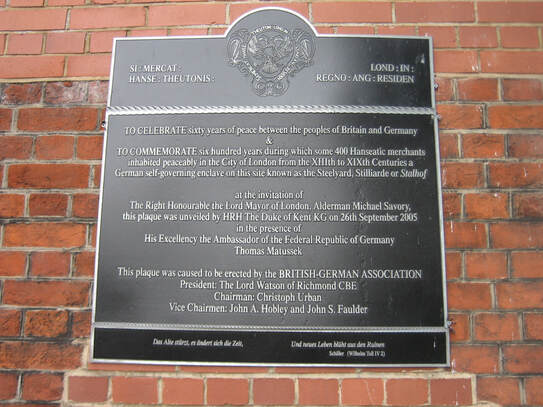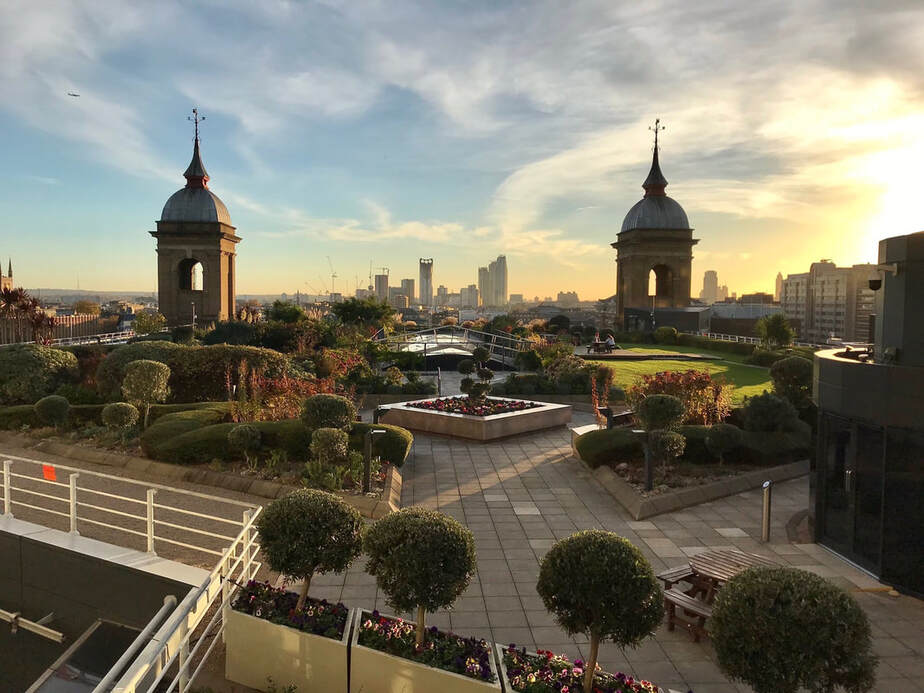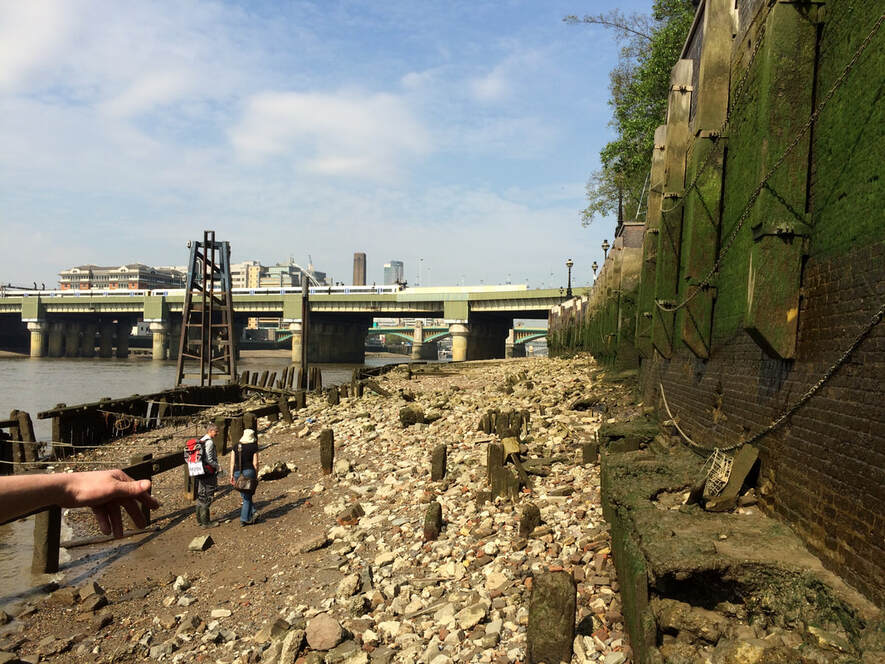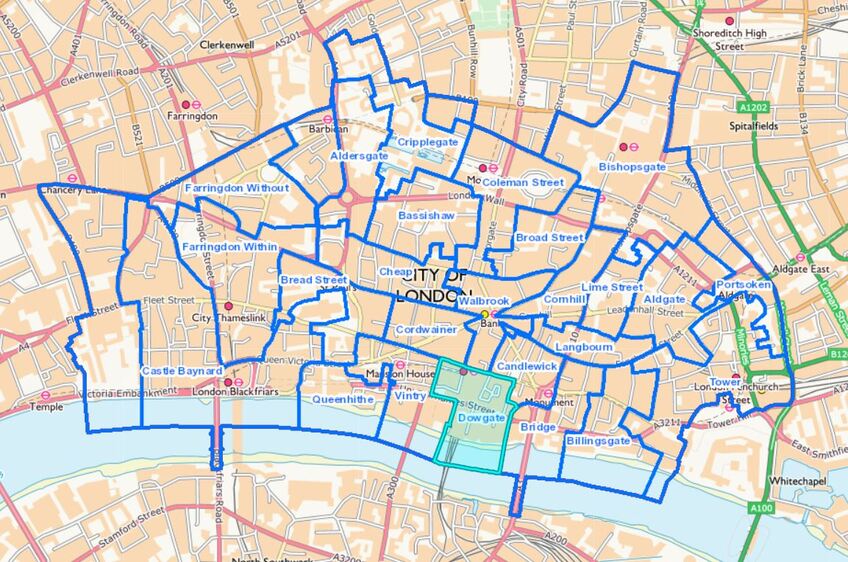About Dowgate Ward
Dowgate from Cannonbridge House
There are 25 Wards in the City of London. These are the voting areas largely set down in medieval London that still exist today. Each Ward elects one Alderman and several Common Councillors. Dowgate has two Common Councillors.
The Ward is dominated by Cannon Street Station and has a complementary mixture of historic buildings and modern development. The new buildings reflect the modern businesses of banking, asset management, legal and financial institutions. They also all boast excellent roof gardens that vie to win plaudits and awards each year. There are some residents in the Ward including the largest residential house (apart from the Mansion House) in the City. This was built immediately after the Great Fire Wards in the City of London. These are the voting areas largely set down in medieval London that still exist today. Each Ward elects one Alderman and several Common Councillors. Dowgate has two Common Councillors.
The Ward is dominated by Cannon Street Station and has a complementary mixture of historic buildings and modern development. The new buildings reflect the modern businesses of banking, asset management, legal and financial institutions. They also all boast excellent roof gardens that vie to win plaudits and awards each year. There are some residents in the Ward including the largest residential house (apart from the Mansion House) in the City. This was built immediately after the Great Fire and has an extensive and award winning garden. Our Church is the Wren designed St Michael Paternoster Royal which is fronted with the lovely open space and fountain at Whittington Gardens.
The Ward is dominated by Cannon Street Station and has a complementary mixture of historic buildings and modern development. The new buildings reflect the modern businesses of banking, asset management, legal and financial institutions. They also all boast excellent roof gardens that vie to win plaudits and awards each year. There are some residents in the Ward including the largest residential house (apart from the Mansion House) in the City. This was built immediately after the Great Fire Wards in the City of London. These are the voting areas largely set down in medieval London that still exist today. Each Ward elects one Alderman and several Common Councillors. Dowgate has two Common Councillors.
The Ward is dominated by Cannon Street Station and has a complementary mixture of historic buildings and modern development. The new buildings reflect the modern businesses of banking, asset management, legal and financial institutions. They also all boast excellent roof gardens that vie to win plaudits and awards each year. There are some residents in the Ward including the largest residential house (apart from the Mansion House) in the City. This was built immediately after the Great Fire and has an extensive and award winning garden. Our Church is the Wren designed St Michael Paternoster Royal which is fronted with the lovely open space and fountain at Whittington Gardens.
River wall and bank in Dowgate
Historically the name Dowgate is said to derive from the Anglo Saxon word “dou” meaning water as the Ward was the site of the original water gate into the City. The river access also meant that it was the ideal spot to eject the City’s rubbish and so it was either literally dumped into the River or else placed on small boats and rowed out to sea. Just to show that things do not always change, the City’s Environmental Services Department is still on the Thames at the boundary of Dowgate Ward. The City’s rubbish now goes in barges down the River.

The Romans made their home in this part of London and the site that is now Cannon Street Station was the Roman Governor’s Palace.
The Ward is home to the most famous Lord Mayor, Dick Whittington who is said to be buried under St Michael Paternoster Royal. There is no marked grave but there is a blue plaque.
The 13th ‐ 16th centuries saw a busy trading time for the English economy that was much assisted by the Hanseatic merchants who had privileged rights to trade in the City. They were based in the Stalhof ‐ Steelyard ‐that is now remembered in the small passageway called Steelyard Passage. The Stalhof sat on the River right under the current Station. The riverside walkway by Cannon Street Bridge has been renamed Hanseatic Walk to commemorate their contribution to City life.
Samuel Pepys is said to have run up the river steps (now by The Banker pub) to warn the Lord Mayor of the Great Fire and those steps are recorded in the badge of the Vintry and Dowgate Wards’ Club. Not far from this spot is the only fire station in the in the City ‐ Dowgate Station. The fire engine boasts the name Dowgate on its door. It also houses the London Fire Brigade’s Fire Investigation team complete with fire dogs.
The four Livery Halls in the Ward reflect the original business carried out here. The Dyers and Skinners both needed access to water to carry on their trades and the odours of their respective crafts were probably not noticed in the general effluence flowing in the Ward. The Tallow Chandlers were likewise the sort of business that you did not particularly want in your back yard. Only the Innholders positively attracted custom to this area. Only hoteliers remain in the City but the ensemble of 17th - 18th century buildings make this area a delightful architectural haven of courtyards and interiors.
Dowgate saw the founding of the Bible Society 1804 and the British Communist Party in 1920 and although there is a predominance of offices in this area there is still room for innovation, but no party politics please.
The Ward is home to the most famous Lord Mayor, Dick Whittington who is said to be buried under St Michael Paternoster Royal. There is no marked grave but there is a blue plaque.
The 13th ‐ 16th centuries saw a busy trading time for the English economy that was much assisted by the Hanseatic merchants who had privileged rights to trade in the City. They were based in the Stalhof ‐ Steelyard ‐that is now remembered in the small passageway called Steelyard Passage. The Stalhof sat on the River right under the current Station. The riverside walkway by Cannon Street Bridge has been renamed Hanseatic Walk to commemorate their contribution to City life.
Samuel Pepys is said to have run up the river steps (now by The Banker pub) to warn the Lord Mayor of the Great Fire and those steps are recorded in the badge of the Vintry and Dowgate Wards’ Club. Not far from this spot is the only fire station in the in the City ‐ Dowgate Station. The fire engine boasts the name Dowgate on its door. It also houses the London Fire Brigade’s Fire Investigation team complete with fire dogs.
The four Livery Halls in the Ward reflect the original business carried out here. The Dyers and Skinners both needed access to water to carry on their trades and the odours of their respective crafts were probably not noticed in the general effluence flowing in the Ward. The Tallow Chandlers were likewise the sort of business that you did not particularly want in your back yard. Only the Innholders positively attracted custom to this area. Only hoteliers remain in the City but the ensemble of 17th - 18th century buildings make this area a delightful architectural haven of courtyards and interiors.
Dowgate saw the founding of the Bible Society 1804 and the British Communist Party in 1920 and although there is a predominance of offices in this area there is still room for innovation, but no party politics please.
For an interactive map, please access the City Corporation's GIS website



